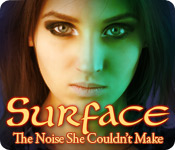In Surface: The Noise She Couldn’t Make, a young girl lies unconscious and alone on a lonely stretch of road. The bloody knife next to her attests to some evil — whether perpetrated on or by her is anyone's guess. Through hidden object areas and mini-games, can you reach her in the darkest corners of her mind and heal her troubled soul?
In past reviews, I've taken game developers to task for going with the tried and true when it comes to theming. Dark castles, impregnable fortresses, pirate ships, and crumbling Victorian mansions. And I guess, in a way, Elephant Games returns somewhat to these popular themes. The key phrase in that preceding sentence is "in a way."
[[Surface-Noise-She-Couldnt-Make-Review-01.jpg]]
Because in Surface: The Noise She Couldn’t Make, you do visit some of these perennially popular spots. The difference is rather than being in the "game world" they are locked inside the noggin of poor little Jane Doe.
Yes, Surface: The Noise She Couldn’t Make doesn’t take place in Valhalla or Vampireland, but within the unconscious brain of a girl found by the side of the road. Next to her is a bloody knife. Is she villain or victim? No one seems to know and little Jane can’t tell us.
[[Surface-Noise-She-Couldnt-Make-Review-03.jpg]]
You, as the gameplayer, are a psychic summoned to the hospital to try and reach Jane in that tortured realm between sleep and wakefulness. How’s that for a premise? As you can see, when it comes to unique game concepts, Surface: The Noise She Couldn't Make is pretty hard to beat.
Another frequent criticism I have with games is the overuse of dark and depressing colors. How many dark and stormy nights must you wade through before someone throws a little fuchsia in the mix? Well, kiss that problem goodbye. The surreal nature of the game’s setting meant the graphic artists had a field day with pinks, purples, and aquamarines. It was like Salvador Dali and Peter Max challenged each other to a fencing duel with their paintbrushes as epees.
[[Surface-Noise-She-Couldnt-Make-Review-04.jpg]]
Game setup was incredibly handy with three invaluable resources at your fingertips. A map, of Jane's mind, of course, showing various locations for gameplay; a full body drawing of Jane for you to keep track of your healing efforts; and a library of cutscene clips for you to revisit as needed.
The hidden object areas were straightforward, yet unique and visually appealing. Just try to keep playing without your head drifting back to the thought that these cluttered little corners were the inner recesses of someone’s mind. My own cerebral hidden object area would certainly have a few more wine bottles and not nearly as many hypodermic needles. Just saying.
[[Surface-Noise-She-Couldnt-Make-Review-02.jpg]]
Lest you think they took their foot off the gas when it came to the mini-games, let me put your mind at ease. They are just as unique as everything else, maybe more so. Popping bubbles to propel a paper boat into little apples, using magnets to alternately repel and attract items into position, and adjusting a lens to bring a skull constellation into focus are just a few of the activities you’ll enjoy.
Several of the cutscenes are movie clips with human actors. There’s more than a little overacting and "scenery chewing," but that’s forgivable when you are experiencing something so incredibly inventive.
[[Surface-Noise-She-Couldnt-Make-Review-05.jpg]]
If I had any criticism, it would be the little "aura flowers" you collect from scene to scene, which convert to "cash" you can spend to decorate your office. Is it me or does this seem a tad insensitive? Hey, I’d love to find the things I need to heal you, but I now have enough flowers for a swivel chair!
If you think you’ve "seen it all" when it comes to hidden object adventure games, I encourage you to think again and download Surface: The Noise She Couldn’t Make. The noises you’ll make most probably will end in "WOW!"

